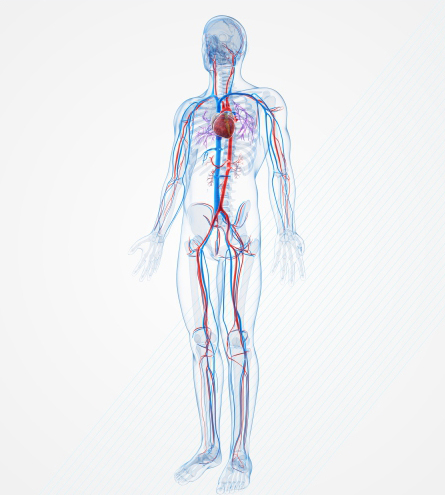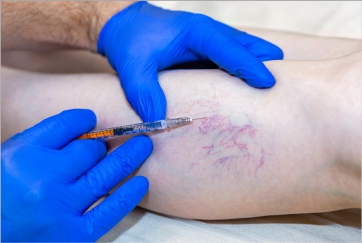Vascular & Endovascular Surgery

Advanced care for your lifelines
The vascular system comprises vessels that carry blood throughout the body. While arteries transport oxygenated blood away from the heart, unoxygenated blood is carried back to the heart through veins. Any disruption of this fragile yet critical process can lead to pain, imbalances in function along with a number of serious complications.
Bhrungi’s Department of Vascular & Endovascular Surgery is fully equipped to treat patients with complex and severe disorders and diseases of the blood vessels and lymph system. Our experts provide comprehensive services that include diagnosis, treatment and management of disorders of the arterial, venous, and lymphatic systems through medical therapy, catheter procedures and surgical reconstruction.
Difference between vascular and endovascular surgery
While both are procedures to treat problems with blood circulation or blockages in the arteries, there is a difference in the approach. Conventional vascular surgery involves incisions and is therefore more invasive and surgical in nature, whereas endovascular surgery is a minimally invasive procedure, usually performed through needle puncture and a sheath.
At Bhrungi, our team comprises top vascular and endovascular surgeons who have the expertise to use advanced surgical techniques including angioplasty and stenting, bypass surgery, and carotid endarterectomy to treat conditions such as peripheral artery disease, aortic disease, carotid artery disease, mesenteric disease among others.
To offer every patient the best care, our experienced surgeons closely collaborate with experts from other specialities including vascular
medicine, cardiovascular medicine, neurology, pain management, and radiology, before coming up with a personalized treatment plan that is tailored to meet the needs of the patient and the situation.
Exceptional expertise in vascular & endovascular procedures
- State-of-the-art CT angiography
- Stenting
- Advanced laser treatment for varicose veins
- Scelerotherapy

Finest treatments for superior outcomes
Carotid Artery Disease
The condition occurs when fatty deposits obstruct the arteries in the neck that deliver blood to the brain and head. The blockage increases the chances of a stroke. The treatment options include Carotid Endarterectomy, Carotid Artery Angioplasty with Stenting, and Transcarotid Artery Revascularization.
Mesenteric Artery Disease
This condition develops when the arteries in the abdomen that supply blood to the bowels and intestines become narrowed or blocked by buildup of fatty matter and plaque. Treatment options include angioplasty therapy or placing a stent in the artery.
Renovascular Disease
A blockage or narrowing of arteries that carry oxygen-rich blood to the kidneys, causes this condition. It can lead to damage to kidney tissue and raise blood pressure. Treatment options include Renal Angioplasty and Stenting or Renal Artery Bypass Surgery.
Aortic Aneurysm
This is a result of an abnormal bulge that occurs in the wall of the aorta, the major blood vessel that carries blood from the heart to the body. It can occur anywhere in the aorta such as the abdomen or chest cavity. Treatment options include Open Surgeries or Endovascular Grafting.
Brain Aneurysm
A result of dilation in a blood vessel in the brain, it can leak or rupture, causing a hemorrhagic stroke. Treatment options include Surgical Clipping or Endovascular Coiling.
Superficial Vein Thrombosis (SVT)
This condition is due to a blood clot that causes swelling and pain in a vein that is just under the skin. Treatment options include Endovenous Ablation or Sclerotherapy.
Chronic Venous Insufficiency (CVI)
This condition occurs when the veins in the legs cannot effectively pump blood back to the heart. This causes blood to pool in the veins leading to swelling in the legs or ankles. Treatment options include Sclerotherapy, Endovenous Laser Therapy, Radiofrequency Closure, Angioplasty and Stent Placement, Ligation and Stripping, Ambulatory Phlebectomy, Vein Bypass.
Congenital Vascular Malformations (CVM)
These are abnormal tangles of arteries, veins and lymph vessels, which disrupt normal flow of blood and lymph fluid and oxygen circulation. Treatment options include Endovascular Embolization and Percutaneous Ablation.
Vasospasm
It is the sudden contraction of the muscular walls of the artery causing it to reduce the amount of blood flow. It can occur in any part of the body including the brain and the heart.
Vascular Steal
The abnormal narrowing of multiple arteries can lead to a condition called “vascular steal.” This occurs when dilation of one vascular network “steals” blood flow from another region within the organ that is already maximally dilated.
Coronary Artery Disease
This condition is a result of plaque building up in the arteries that supply oxygen-rich blood to the heart. The narrowing or blockage in the arteries could lead to a heart attack. Treatment options include Balloon Angioplasty and Stenting, Coronary Artery Bypass Graft Surgery, and Enhanced External Counterpulsation.
Peripheral Arterial Disease (PAD)
This is a common circulatory problem in which the arteries become narrow due to buildup of fatty plaque, resulting in reduced blood flow to the limbs, especially the legs. Treatment options include Angioplasty, Bypass Surgery or Thrombolytic Therapy.
Vertebrobasilar Insufficiency
This condition is caused by poor blood flow to the back area of the brain, due to hardening or blockage of arteries through the build-up of plaque. Treatment options include Bypass Grafting, Direct Arterial Transposition, Endarterectomy, Angioplasty and Stenting.
Aortic Dissection
It is the result of a tear in the inner wall of the aorta, which causes blood to enter the space between layers. In case of a rupture, it can prove fatal. Treatment options include Thoracic Aortic Aneurysm Open Repair or Endovascular Aneurysm Repair.
Pulmonary Embolism (PE)
It is the result of a blockage in one of the pulmonary arteries, restricting blood flow to the lungs. It is commonly caused by blood clots that travel to the lungs usually from deep veins in the legs. Treatment options include Clot Removal via Catheter or Vein Filter
Varicose Veins
These are enlarged, swollen and twisting veins near the surface of the skin, caused by weak or damaged valves. Treatment options include Sclerotherapy, Laser Therapy, Catheter-assisted procedures using Radiofrequency or Laser, High Ligation and Vein Stripping, Ambulatory Phlebectomy, Endoscopic Vein Surgery.
Lymphedema
Caused by a blockage in the lymphatic system that prevents lymph fluid from draining, it results in swelling in the arms or legs. It can be managed with early diagnosis and good care of the affected limb.
Inflammatory Vascular Disease
Also known as Vasculitis, it is an inflammation of the blood vessels that can restrict blood flow resulting in organ and tissue damage. Treatment options include surgical procedures to reduce the risk of a ruptured aneurysm or to unblock arteries to restore blood flow.
Raynaud's Phenomenon
It refers to severe, temporary narrowing of the arteries of the fingers or toes in response to cold or stress. It results in the affected area turning white, blue and then red.
MEET OUR TEAM
Dr. Venu Gopal
MBBS, DNB
Consultant – Vascular & Endovascular Surgery








